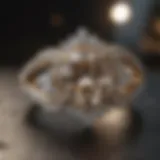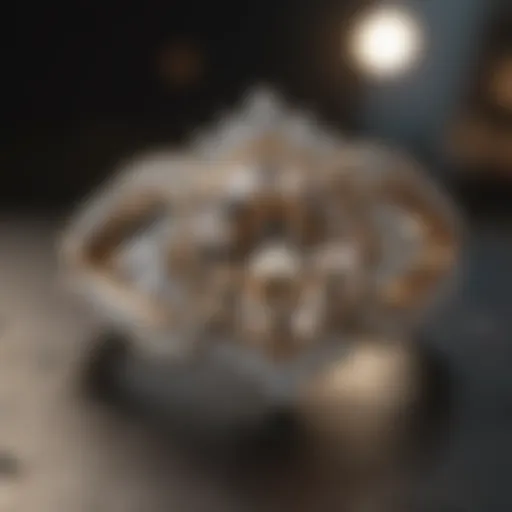Distinguishing Cubic Zirconia from Diamond: A Guide
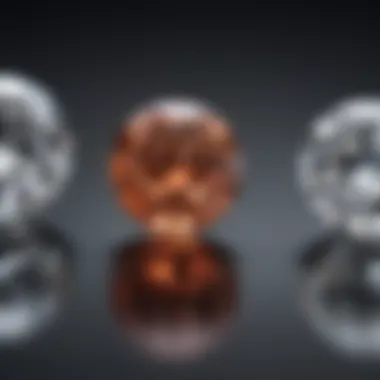

Intro
Understanding the differences between cubic zirconia and diamonds is crucial for gemstone enthusiasts, collectors, and jewelry designers. Both gems are often visually comparable, leading to confusion among buyers and sellers alike. This article aims to clarify how these two gemstones differ through various methods of identification. By delving into their respective properties, we will present a comprehensive guide that will aid you in recognizing unique characteristics and forming a deeper appreciation for each stone.
Overview of Gemstones and Minerals
Gemstones have held significant cultural and societal value through history. Ancient civilizations utilized jewels for adornment as well as for their supposed protective and healing properties. Understanding these historical contexts enriches the current appreciation of gemstones, including cubic zirconia and diamonds.
History of Gemstone and Mineral Use
The use of gemstones dates back thousands of years. For example, diamonds have been revered since their discovery, often viewed as symbols of power and wealth. Cubic zirconia, on the other hand, was developed in the 1970s as a cheaper alternative to diamonds.
Significance in Culture and Society
In many societies, gemstones symbolize various qualities such as love, success, and strength. Diamonds are often associated with status, while cubic zirconia appeals to a budget-conscious market seeking a similar aesthetic without the high cost.
Gemstone Formation and Properties
To distinguish cubic zirconia from diamonds effectively, understanding their formation processes provides helpful insights.
Formation Process of Gemstones
Diamonds form deep within the Earth's mantle under high pressure and temperature over millions of years. This natural process results in unique crystalline structures. Cubic zirconia is a synthetic stone created in a laboratory, designed to mimic the appearance of a diamond.
Properties that Define Gemstones
Both diamonds and cubic zirconia exhibit distinct properties. For instance, diamonds are harder due to their carbon-based structure. Conversely, cubic zirconia is less durable, as it does not have the same crystalline lattice.
Classification based on Color, Hardness, and Luster
Diamonds possess a broader range of colors determined by impurities in the crystal structure. Cubic zirconia is more likely to be of a consistent color, especially in white varieties. Diamonds score a 10 on the Mohs hardness scale, while cubic zirconia typically scores around 8 to 8.5.
Identifying and Evaluating Gemstones
Identifying gemstones involves a series of techniques that highlight differences between cubic zirconia and diamonds.
Factors Affecting Gemstone Value
Factors like cut, clarity, color, and carat weight significantly impact a gemstone's value. Diamonds usually carry a higher price due to their rarity and natural origin.
Techniques for Gemstone Identification
- Visual Inspection: Using a loupe to check for inclusions can assist in distinguishing between the two types.
- Refractive Index Testing: Diamonds have a higher refractive index than cubic zirconia.
- Thermal Conductivity Tests: Diamonds conduct heat better than cubic zirconia, offering a practical assessment method.
Assessing Gemstone Quality
Quality assessment often considers an overall examination of clarity and brilliance. While both stones can be brilliant, the sparkle of a diamond remains unmatched.
Caring for Gemstones
Proper care ensures the longevity and brilliance of your gemstones.
Cleaning and Storing Gemstones Properly
Keep gemstones in separate pouches or compartments to avoid scratches. Clean them gently to maintain shine.
Avoiding Common Mistakes in Gemstone Care
Avoid cleaning chemicals, especially for diamonds, as they can damage adjacent settings.
Preservation Tips for Specific Gem Types


To maintain their appearance, store cubic zirconia away from sunlight and extreme temperatures, as they can degrade the material over time.
Understanding how to differentiate cubic zirconia from diamonds is not only advantageous for collectors but also essential for informed purchasing decisions, ultimately leading to a more satisfying gemstone experience.
Prologue to Cubic Zirconia and Diamonds
Cubic zirconia and diamonds often draw attention for their remarkable visual similarities. However, understanding the distinctions between these two gemstones is crucial for jewelry enthusiasts, collectors, and designers alike. As both have a vast presence in the market, knowing how to differentiate them can influence purchasing decisions significantly.
In this section, we will explore the characteristics that define each gemstone. Recognizing these traits goes beyond just mere curiosity; it ensures informed choices are made, enhancing the value of collections and jewelry designs.
Overview of Gemstone Characteristics
Cubic zirconia, commonly referred to as CZ, is a synthetic stone created in a lab environment. It exhibits a sparkle and clarity that can rival diamonds. The primary component of CZ is zirconium dioxide, which results in a distinct refractive index. Diamonds, on the other hand, are naturally occurring carbon crystals formed over millions of years, typically under extreme pressure and heat deep within the earth’s crust. This natural formation contributes to their unique characteristics such as hardness and brilliance.
Key Characteristics of Each Gemstone
- Cubic Zirconia:
- Diamonds:
- Created synthetically through a controlled process.
- Generally more flawless than natural diamonds.
- Significantly less expensive than diamonds.
- Formed naturally from carbon with a specific crystal structure.
- Recognized for unmatched hardness and brilliance.
- Varied in price, often very high due to rarity.
Thus, while cubic zirconia can effectively imitate diamonds, their origins and qualities differ in fundamental ways.
Historical Context of CZ and Diamonds
The journey of diamonds spans thousands of years, dating back to ancient times when they were believed to hold mystical powers. Diamonds became symbols of wealth, status, and even love. Their history is rich, marked by discovery and significant cultural significance. They emerged as favored stones for engagement rings in the 19th century, particularly in Western cultures, establishing diamonds as the ultimate gemstone.
Cubic zirconia, by contrast, is a relatively recent invention. First created in the 1970s, it emerged as a response to the demand for affordable gemstone alternatives. Its synthetic nature allows for consistency in quality and size, catering to consumers who desire the appearance of luxury without the associated costs. Although its popularity has surged, understanding its place in history provides insight into the ongoing conversation surrounding value and authenticity in gemstones.
This historical understanding not only enriches one’s appreciation of these gems but also influences consumer behavior in the jewelry market today.
Chemical Composition
Understanding the chemical composition of gemstones is crucial for distinguishing cubic zirconia from diamonds. The unique properties and characteristics of each stone stem directly from their elemental makeup. This section explores how chemical composition plays a vital role in their identification, analyzing specific elements that define each gem.
Diamond's Structure
Diamonds are composed of carbon atoms arranged in a crystalline structure. Each carbon atom forms four strong covalent bonds with neighboring carbon atoms, resulting in an extremely rigid three-dimensional lattice. This structure contributes not only to the hardness of diamonds but also to their brilliant light performance. The tight arrangement of carbon atoms ensures minimal light dispersion, creating a more concentrated brilliance.
Key Characteristics of Diamonds:
- Hardness: Diamonds are the hardest known natural material, rated 10 on the Mohs scale.
- Conductivity: Diamonds are good conductors of heat due to their strong carbon bonds.
- Natural Origin: They form under high-pressure and high-temperature conditions deep in the Earth’s mantle over billions of years.
These factors combined make diamonds not only visually appealing but also incredibly durable, reinforcing their value in jewelry.
Cubic Zirconia's Composition
Cubic zirconia, or CZ, is a synthetic gem made primarily of zirconium dioxide. Unlike diamonds, cubic zirconia does not occur naturally; it is artifically created in laboratories. The manufacturing process allows for the inclusion of trace elements that can modify its color and enhance its visual appeal. The crystalline structure of CZ differs from diamonds, as it is typically cubic rather than the tetrahedral structure seen in diamonds.
Key Characteristics of Cubic Zirconia:
- Formation: Produced through controlled heat and pressure, making it more accessible and affordable than natural diamonds.
- Hardness: Rated around 8 to 8.5 on the Mohs scale, CZ is durable but less so than diamonds.
- Weight: Cubic zirconia is denser than diamonds, adding to its weight.
The understanding of where each stone originates and how their structure affects their physical properties provides vital clues for identification. These differences in chemical composition are fundamental for gemstone enthusiasts and jewelry designers alike, as they impact not only the appearance but also the value and use of each gem.
Physical Properties
Understanding the physical properties of cubic zirconia and diamonds is crucial for distinguishing between the two gemstones. These properties not only affect their appearance but also their longevity and suitability for various applications. Physical attributes encompass hardness, density, weight, and optical characteristics, each of which plays a significant role in identifying and comparing these gems. A clear grasp of these properties assists gem enthusiasts and collectors in making informed decisions.
Hardness and Durability
Hardness indicates how well a gemstone resists scratches and abrasions. Diamonds are renowned for their exceptional hardness, rated at 10 on the Mohs scale. This makes them the hardest known natural material. As a result, diamonds stand up well to daily wear and tear, adding value for those who desire durable jewelry pieces.
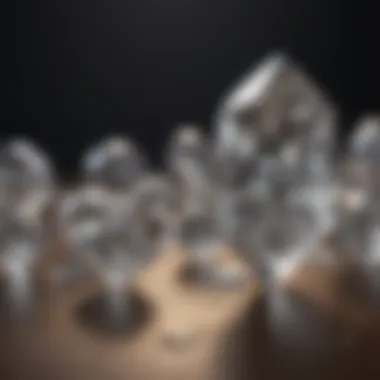

In contrast, cubic zirconia has a hardness rating of around 8-8.5 on the Mohs scale. While still resilient, this makes CZ more vulnerable to scratches. For jewelry that is exposed to rough conditions, choosing diamond over cubic zirconia becomes a practical consideration.
Density and Weight
Density refers to the mass of a gemstone relative to its volume. Diamonds have a greater density compared to cubic zirconia. A diamond's density typically ranges from 3.5 to 3.53 grams per cubic centimeter, while cubic zirconia has a density of about 5.6 to 6.1 grams per cubic centimeter.
This difference indicates that cubic zirconia will feel heavier than diamond when comparing similarly sized stones. Therefore, weight can act as an additional clue in identification, especially during manual inspection. Awareness of these metrics is useful for jewelers and buyers alike.
Optical Characteristics
Optical characteristics include refractive index, birefringence, and dispersion, which provide insight into how gemstones interact with light. This section will delve into these components for deeper understanding.
Refractive Index
The refractive index is a measure of how light bends as it passes through a gemstone. Diamonds possess a high refractive index ranging from 2.42 to 2.45, which contributes to their impressive sparkle and brilliance. This higher refractive index enhances a diamond's ability to reflect light, resulting in a notable fire and scintillation.
Cubic zirconia has a lower refractive index of approximately 2.15 to 2.18. While CZ can still exhibit brilliance, it does not quite match the same level of optical performance as diamonds. This difference provides a crucial capability for discernment, especially under proper lighting conditions.
Birefringence
Birefringence measures the extent to which a material refracts light in two different directions. Diamonds are isotropic, meaning they exhibit no birefringence. This characteristic contributes to their uniform appearance under magnification. In contrast, cubic zirconia is birefringent, resulting in visible doubling of the facets when viewed through a loupe or microscope.
Understanding this optical property helps jewelers and collectors identify each gemstone type. It is a beneficial aspect that adds precision to the identification process.
Dispersion
Dispersion refers to the separation of light into its component colors as it passes through a gemstone. Diamonds have a lower dispersion than cubic zirconia, which results in a more subtle play of colors. The dispersion in diamonds is about 0.044, whereas cubic zirconia has a higher dispersion rate at approximately 0.066.
This higher dispersion in cubic zirconia leads to a rainbow effect that is often more pronounced. Although some may find this attractive, aficionados seeking classic brilliance prefer diamonds for their elegance. Recognizing these qualities helps individuals choose based on aesthetic preference.
Understanding the physical properties of gems provides clarity on their differences, aiding in informed purchasing and collection decisions.
Visual Differences
The ability to distinguish between cubic zirconia and diamonds is crucial for individuals involved in the gemstone market. The visual properties of these gemstones can reveal much about their authenticity and value. Understanding the specific elements that contribute to their different appearances not only enhances one’s knowledge but also improves decision-making when purchasing jewelry.
Sparkle and Fire
Cubic zirconia is known for its brilliant sparkle and fire, which can sometimes surpass that of diamonds. This enhanced brilliance comes from its higher refractive index. While both gemstones exhibit fire, or the dispersion of light into various colors, cubic zirconia may display a more vibrant spectrum due to its composition.
On the other hand, diamonds are characterized by their unique ability to reflect light. The way diamonds interact with light produces a more subtle sparkle, which some may describe as refined or understated. This quality is a result of the diamond's cut and the way it handles light internally. When comparing these two stones, observing the light-play can be incredibly helpful.
It's essential to note that the brightness of a stone can also depend on the conditions in which it is viewed. Natural sunlight may create different effects on both stones compared to artificial indoor lighting. To evaluate sparkle and fire, one should observe the gemstones under various light sources.
Color and Clarity
Cubic zirconia is typically flawless, a quality that is highly attractive to many buyers. Most CZ stones are produced in a pure white color; however, they can also be created in various colors. Meanwhile, diamonds can vary significantly in color and clarity. While many diamonds are clear or have a slight tint, some can feature a range of colors that enhance their value, such as blue, yellow, or pink.
The clarity of diamonds is graded on a scale from flawless to included, with inclusions being internal blemishes or external imperfections. In contrast, cubic zirconia is manufactured, eliminating most imperfections during production. This difference can often make CZ appearing very clean and perfect compared to natural diamonds.
Identification Methods
The ability to identify cubic zirconia from diamonds is vital for those in the jewelry industry, collectors, and enthusiasts. Understanding these identification methods not only ensures authenticity but also enhances value perception. Each technique possesses its unique benefits, helping to provide a clearer distinction between these two popular gemstones.
Magnification Techniques
Using magnification can reveal the subtle differences between cubic zirconia and diamonds. A jeweler's loupe or microscope allows for close examination of inclusions and surface details. Diamonds typically feature unique inclusions called
Market Overview
The market overview of cubic zirconia (CZ) and diamonds provides essential context for understanding their distinct characteristics and how these differences affect their respective values and uses. Knowing these aspects can guide both consumers and collectors, ensuring informed decisions when purchasing or comparing these gemstones.
Value Comparison
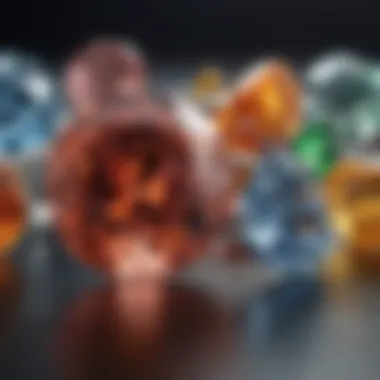

Cubic zirconia and diamonds differ significantly in their market value. Diamonds have long been seen as a symbol of luxury and wealth. Their rarity primarily drives their high prices. In contrast, cubic zirconia is synthesized and can be manufactured in large quantities, making it a more affordable alternative.
Notably, the pricing for cubic zirconia typically ranges from $20 to $40 per carat, depending on various factors such as cut and clarity. Meanwhile, diamonds can fetch prices ranging from hundreds to thousands of dollars per carat, largely influenced by the 4Cs: carat weight, color, clarity, and cut.
Additionally, the resale value of diamonds remains strong in the market. On the other hand, cubic zirconia does not hold significant resale value and is often considered disposable rather than an investment.
Popularity in Jewelry
Cubic zirconia and diamonds both have prominent places in the jewelry market, but their applications often differ. Diamonds are frequently associated with engagement rings, wedding bands, and high-end jewelry, signifying commitment and status. Their enduring quality and beauty make them an enduring choice for significant life events.
Cubic zirconia, being a synthetic stone, finds its popularity in fashion jewelry. It offers a brilliant appearance similar to diamonds at a fraction of the cost. This affordability allows consumers to purchase larger or more elaborate pieces without a significant financial commitment.
Moreover, CZ appeals to those who prefer changeable fashion styles, as it allows for a versatile range of jewelry without financial strain. The fashion-forward nature of cubic zirconia makes it attractive for those seeking trendy designs without the necessity of permanent investment.
In summary, while both gemstones have unique offerings in the market, their differences in value and usage characterize their positions in the jewelry industry.
Applications of Cubic Zirconia and Diamonds
Prelims to Applications
Understanding the applications of cubic zirconia and diamonds is vital for appreciating their respective value and versatility. This section examines how these gemstones are used across various fields, highlighting their importance not only in jewelry but also in industrial settings. The different applications illustrate the unique properties that each gemstone brings to the table.
Use in Fashion and Fine Jewelry
Cubic zirconia has become a popular choice in the fashion jewelry market. Its affordability and ability to mimic the appearance of diamonds make it a favored option for many consumers. Jewelry designers often incorporate CZ into their collections to provide a more accessible alternative to precious diamonds without compromising on aesthetics. The wide range of colors available in cubic zirconia also allows for creative designs that appeal to diverse tastes.
In fine jewelry, diamonds continue to hold a prestigious status. Their brilliance and rarity contribute to their value. High-quality diamonds, particularly those that are colorless and free of inclusions, are sought after by collectors and investors alike. The significance often attributed to diamonds can elevate their setting in pieces intended for special occasions, such as engagement rings and anniversary gifts.
When comparing the two, it's insightful to note:
- Cost: CZ is significantly cheaper than diamonds, making it accessible to a larger audience.
- Durability: Although diamonds are the hardest known natural material, CZ can still offer reasonable durability for everyday wear at a lower price.
- Ethical Considerations: For buyers concerned with sourcing, CZ presents an alternative as it is lab-made, often viewed as a more ethical choice compared to mined diamonds.
This diversity in application not only enhances the market for both gemstones but also caters to varying consumer preferences and budgets.
Industrial Applications
Beyond the realm of jewelry, both cubic zirconia and diamonds find significant usage in industrial applications. Diamonds are often employed in cutting, grinding, and drilling. Their unparalleled hardness makes them ideal for tools and machinery that require precision and efficiency. For instance, diamond-tipped drill bits are used in construction and mining due to their efficacy and longevity.
Cubic zirconia, while not as widely recognized in industrial contexts, has its own applications. It can be used in specific cutting and grinding tools, particularly where a cost-effective solution is needed without sacrificing too much performance. Its properties also lend it to be used in optical instruments, particularly where light transmission is important, given its favorable refractive indices.
Here are some notable applications:
- Diamonds:
- Cubic Zirconia:
- Cutting Tools: Diamond blades and bits.
- Manufacturing: Used in watches and electronic components.
- Medical Equipment: Assisting in dental procedures.
- Optical Devices: Used in lasers and devices requiring high clarity.
In summary, the applications of these gemstones extend far beyond aesthetics, serving critical roles in industries that demand durability, precision, and adaptability. This understanding reinforces the significance of recognizing cubic zirconia and diamonds as not just decorative items, but as valuable resources with diverse applications.
Culmination
Understanding the differences between cubic zirconia and diamonds is essential for anyone involved in the gemstone market, from collectors to jewelry designers. This knowledge facilitates informed decisions regarding purchases and the valuation of pieces in one’s collection.
Summary of Key Distinctions
Both cubic zirconia and diamonds share a compelling aesthetic appeal, yet their distinctions run deeper than just appearance. Key aspects include:
- Chemical Composition: Diamonds are carbon structures, while cubic zirconia is a synthesized crystal made from zirconium dioxide.
- Physical Properties: Diamonds are harder, scoring a 10 on the Mohs scale, whereas cubic zirconia ranks at 8 to 8.5. This hardness affects their durability in jewelry.
- Optical Characteristics: Diamonds exhibit superior brilliance and dispersion compared to cubic zirconia. The refractive index of diamonds (2.42) contrasts with that of CZ (2.15 to 2.18).
- Market Value: Diamonds hold significant market value, being precious gems, while cubic zirconia is more affordable, often used as a diamond substitute.
Understanding these distinctions aids in identifying each gemstone effectively, contributing to smarter consumer choices and value assessments.
Importance of Accurate Identification
Accurate identification of cubic zirconia and diamonds is critical in various contexts. For collectors, distinguishing between these stones affects authenticity and perceived value. Jewelry designers benefit from this understanding when sourcing materials, ensuring quality and customer satisfaction. Furthermore, consumers gain assurance that they are making informed purchasing decisions.
The ability to accurately discern between cubic zirconia and diamonds can save money and prevent disappointment, especially in professional settings such as auctions or appraisals.
In summary, the significance of knowing how to distinguish these gemstones cannot be overstated. The clarity in identification not only enhances the appreciation of each gem but also supports integrity within the jewelry market.
